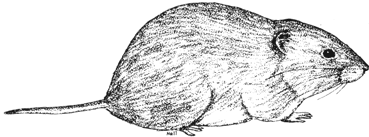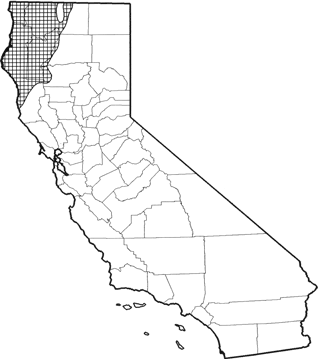
Creeping Vole
Distribution, Abundance, and Seasonality
In California, the creeping vole is found in the northwest corner of the state from Del Norte and Siskiyou cos. south to Mendocino Co., including the extreme western portions of Tehama and Shasta cos. Common to abundant in herbaceous and shrubby understories of riparian and coniferous forests, including burned and clearcut areas. Also common at times in grassland and wet meadow habitats (Goertz 1964, Gashwiler 1972), as well as cropland.

Range Map
Specific Habitat Requirements
Feeding: Feeds on grasses and forbs from ground surface, and some underground fungi (Maser et al. 1978).
Cover: Seeks cover in ground litter, dense herbaceous undergrowth, and in burrows and log cavities. Burrows are excavated in soft soil. Occasionally, the burrows of other small mammals (particularly moles) are used.
Reproduction: A nest of dried grass is constructed in burrow.
Water: Probably does not require free water.
Pattern: Prefers herbaceous habitat or shrublands with herbaceous openings, with soft soil for burrowing. Early successional stages of burned and cutover areas at the edge of coniferous forests support the highest densites.
Species Life History
Activity Patterns: Yearlong activity. Mainly nocturnal, but probably forages near nest throughout the day.
Seasonal Movements / Migration: None.
Home Range: In Oregon clearcuts, home ranges averaged 0.06 ha (0.14 ac) for males, and 0.09 ha (0.22 ac) for females (Gashwiler 1972). Densities range up to 72/ha (29/ac) (Sullivan and Krebs 1981), and may fluctuate with a periodicity of 3-4 yr in optimum habitat (see Carraway and Verts 1985).
Territory: No data found.
Reproduction: Breeds from January to late November, peaking from April to May. Gestation period averages 24 days. An average of 3-4 young are born (range 1-8). Averages 4-8 litters per yr. Females may be sexually receptive as early as 22 days of age, but most pregnancies occur after 42 days (Cowan and Arsenault 1954, Gashwiler 1972).
Niche: Predators probably include snakes, hawks, owls, coyotes, foxes, and bobcats. Densities are lower, and populations do not cycle, when Microtus townsendii is present (Sullivan and Krebs 1981).
Sources & References
California Department of Fish and Game, 1999.
California's Wildlife, Sacramento, CA.
Written by: P. Brylski, J. Harris, reviewed by: H. Shellhammer, edited by: R. Duke, S. Granholm
Carraway, L. N., and B. J. Verts. 1985. Microtus oregoni. Mammal. Species No. 233. 6pp. Cowan, I. McT., and M. G. Arsenault. 1954. Reproduction and growth in the creeping vole, Microtus oregoni serpens Merriam. Can. J. Zool. 32:198-208. Gashwiler, J. S. 1972. Life history notes on the Oregon vole, Microtus oregoni. J. Mammal. 53:558-569. Goertz, J. W. 1964. Habitats of three Oregon voles. Ecology 45:846-848. Hooven, E. F. 1973. Response of the Oregon creeping vole to the clearcutting of a Douglas- fir forest. Northwest Sci. 47:256-264. Maser, C., J. M. Trappe, and R. A. Nussbaum. 1978. Fungal-small mammal inter- relationships with emphasis on Oregon coniferous forests. Ecology 59:799-809. Sullivan, T. P., and C. J. Krebs. 1981. Microtus population biology: demography of M. oregoni in southwestern British Columbia. Can. J. Zool. 59:2092-2102.
California Animal Facts | California's Wildlife